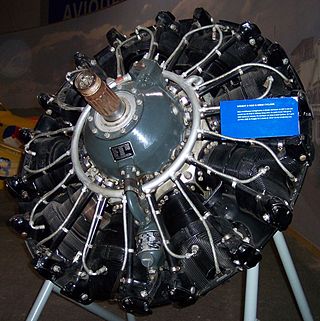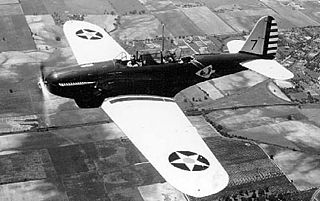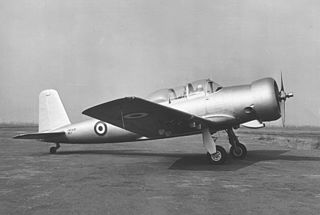
The Lockheed Model 9 Orion is a single-engined passenger aircraft built in 1931 for commercial airlines. It was faster than any American military aircraft of that time. Designed by Richard A. von Hake, it was the last wood aircraft produced by the Lockheed Aircraft Corporation.

The Wright R-3350 Duplex-Cyclone is an American twin-row, supercharged, air-cooled, radial aircraft engine with 18 cylinders displacing nearly 3,350 cubic inches (54.9 L). Power ranged from 2,200 to 3,700 hp, depending on model. Developed before World War II, the R-3350's design required a long time to mature, and was still experiencing problems with reliability when used to power the Boeing B-29 Superfortress.

The Pratt & Whitney R-4360 Wasp Major is an American 28-cylinder four-row radial piston aircraft engine designed and built during World War II. At 4,362.5 cu in (71.5 L), it is the largest-displacement aviation piston engine to be mass-produced in the United States, and at 4,300 hp (3,200 kW) the most powerful. First run in 1944, it was the last of the Pratt & Whitney Wasp family, and the culmination of its maker's piston engine technology.

The Wright R-1820 Cyclone 9 is an American radial engine developed by Curtiss-Wright, widely used on aircraft in the 1930s through 1950s. It was produced under license in France as the Hispano-Suiza 9V or Hispano-Wright 9V, and in the Soviet Union as the Shvetsov M-25.

The Pratt & Whitney R-1830 Twin Wasp is an American air-cooled radial aircraft engine. It displaces 1,830 cu in (30.0 L) and its bore and stroke are both 5.5 in (140 mm). The design traces its history to 1929 experiments at Pratt & Whitney on twin-row designs. Production began in 1932 and it was widely used during the 1930s.

The Pratt & Whitney R-1535 Twin Wasp Junior was an engine used in American aircraft in the 1930s. The engine was introduced in 1932 as a 14-cylinder version of the 9-cylinder R-985. It was a two-row, air-cooled radial design. Displacement was 1,535 cu in (25.2 L); bore and stroke were both 5+3⁄16 in (132 mm).

The Pratt & Whitney R-985 Wasp Junior is a series of nine-cylinder, air-cooled, radial aircraft engines built by the Pratt & Whitney Aircraft Company from the 1930s to the 1950s. These engines have a displacement of 985 in3 (16 L); initial versions produced 300 hp (220 kW), while the most widely used versions produce 450 hp (340 kW).

The Pratt & Whitney R-1690 Hornet was a widely used American aircraft engine. Developed by Pratt & Whitney, 2,944 were produced from 1926 through 1942. It first flew in 1927. It was a single-row, 9-cylinder air-cooled radial design. Displacement was 1,690 cubic inches. It was built under license in Italy as the Fiat A.59. In Germany, the BMW 132 was a developed version of this engine. The R-1860 Hornet B was an enlarged version produced from 1929.

The Douglas Dolphin is an American amphibious flying boat. While only 58 were built, they served a wide variety of roles including private air yacht, airliner, military transport, and search and rescue.

The P-1 Hawk was a 1920s open-cockpit biplane fighter aircraft of the United States Army Air Corps. An earlier variant of the same aircraft had been designated PW-8 prior to 1925.

The Consolidated P-30 (PB-2) was a 1930s United States two-seat fighter aircraft. An attack version called the A-11 was also built, along with 2 Y1P-25 prototypes and YP-27, Y1P-28, and XP-33 proposals. The P-30 is significant for being the first fighter in United States Army Air Corps service to have retractable landing gear, an enclosed and heated cockpit for the pilot, and an exhaust-driven turbo-supercharger for altitude operation.

The Boeing Model 15 is a United States single-seat open-cockpit biplane fighter aircraft of the 1920s, manufactured by the Boeing company. The Model 15 saw service with the United States Army Air Service and with the United States Navy as a carrier-based fighter.

The Vought O2U Corsair was a 1920s biplane scout and observation aircraft. Developed by Vought Corporation, the O2U was ordered by the United States Navy (USN) in 1927. Powered by a 400 hp (298 kW) Pratt & Whitney R-1340 engine, it incorporated a steel-tube fuselage structure and a wood wing structure with fabric covering. Many were seaplanes or amphibians.

The Boeing P-29 and XF7B-1 were an attempt to produce a more advanced version of the highly successful P-26. Although slight gains were made in performance, the U.S. Army Air Corps and U.S. Navy did not order the aircraft.

The Wright R-975 Whirlwind was a series of nine-cylinder air-cooled radial aircraft engines built by the Wright Aeronautical division of Curtiss-Wright. These engines had a displacement of about 975 cu in (15.98 L) and power ratings of 300–450 hp (220–340 kW). They were the largest members of the Wright Whirlwind engine family to be produced commercially, and they were also the most numerous.

The Thomas-Morse O-19 was an American observation biplane built by the Thomas-Morse Aircraft Company for the United States Army Air Corps.

The Fiat G.49 was an Italian two-seat basic trainer designed by Giuseppe Gabrielli and built by Fiat.

The Lockheed XC-35 is a twin-engine, experimental pressurized airplane. It was the second American aircraft to feature cabin pressurization. It was initially described as a "supercharged cabins" by the Army. The XC-35 was a development of the Lockheed Model 10 Electra that was designed to meet a 1935 request by the United States Army Air Corps for an aircraft with a pressurized cabin.

The Boeing Model 6D, a.k.a. Boeing Model 6E, Boeing B-1D and Boeing B-1E, was an American pusher biplane flying-boat built by Boeing between 1928 and 1929.
The C-8 Eightster was a single-engine airliner developed by Granville Brothers Aircraft that did not go into production.






















